New Features by Release
New in 8.5.1
Support for Conversation Manager Templates in Test Scenarios
In the initial 8.5.001 release of GRS, the Test Scenario feature did not support rules that were created using the Conversation Manager (CM) template. This is because the Test Scenario feature in release 8.5.001 works by taking the input data (a set of one or more facts with different fields) that is configured by the user and building the appropriate Fact model, then running the rules under GRAT using that set of data. In release 8.5.1, the Test Scenario feature now supports rules based on the CM template.
Data Structure in CM
With Conversation Manager, the data is in a hierarchical JSON format of Customer -> Service -> State -> Task. Any given Customer may have one or more Services. Each Service may be in at most one State at a time. Each State may have one or more Tasks. Tasks may also be associated directly with Services.
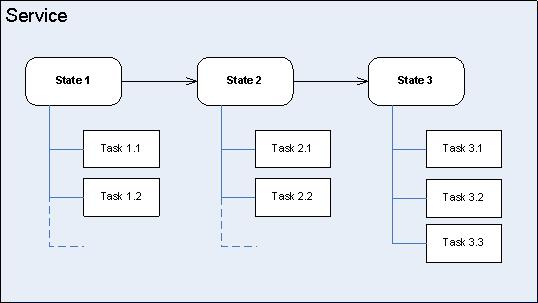
So the Customer, Services, States and Tasks Facts have now been added the lists of Facts that can be defined as Given fields, and the RulesResults Fact has been added to the list of Facts that can be defined as an Expectation.
Important
The current CM Template is only interested in the Type, Start Time, and Completion Time (if any) of Services, States, and Tasks.
Each of the new values is represented by a JSON string which will be the value for that field.
Now, when the type of rule for which you want to create a test scenario is a Conversation Manager rule (based on the Conversation Manager template), a series of different values for the Given and Expectation elements that reflect these more complex data structures are available. In the example below you can see the Customer > Service > State > Task structure is reflected by the four @class entries in the drop-down list of Givens and the @class:RulesResults entry in the drop-down list of Expectations.
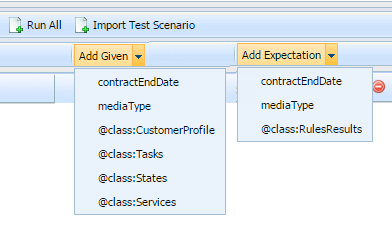
When you select an @class entry, a new column is added. Click on a grid cell under the new column to bring up the edit dialog for that entry. The additional data listed below can be selected as either a Given or an Expectation.
Additional CM Template Objects
Givens
The list below shows the additional provided data.
- Available by selecting one of the @class entries:
- Add Customer Attribute
- Add Service
- Add Service Type
- Add Service Start Time
- Add Service Completion Time
- Add State
- Add State Type
- Add State Start Time
- Add State Completion Time
- Add Task
- Add Task Type
- Add Task Start Time
- Add Task Completion Time
- Available for direct selection from Givens:
- Add Interaction Media Type
- Add Contract End Date
Expectations
The list below shows the additional expected results:
- Update Customer Attribute
- Request Specific Agent
- Request Agent Group
- Request Place Group
- Request Skill
- Send Communication to Customer
- Block Communication to Customer
- Offer Service Resumption
- Offer Survey to Customer
Edit Dialogs
To create entries for the Givens and Expectations of your Conversation Manager test scenario, select the relevant @class item and use the sample additional edit dialogs shown below.
Givens




Expectations

Nested Solution Business Hierarchy
In release 8.5.1 of Genesys Rules Authoring tool, if you have permission to create a new rule (Rule Package - Create) you can now add a new Rule Package at any node in the business hierarchy (a nested solution), rather than just at the first level.
[+] FULL DESCRIPTION
| Non-Nested Solution
|
Nested Solution
|
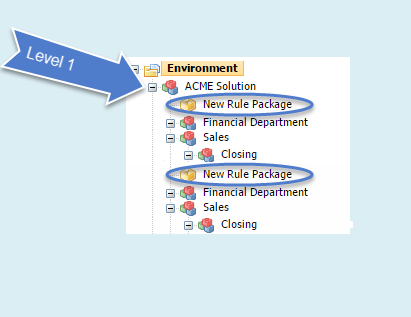
|
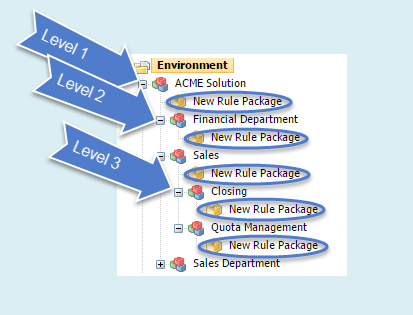
|
This means that:
- Your business hierarchy can be more easily organized.
- The need for lots of duplication and repetition at the Solution level in more complex business hierarchies is now removed.
- Individual users can be restricted using Role-Based Access Control to specific sub-nodes (for example, Departments and Processes).
Importing Rule Packages
Because rules can be associated with sub-nodes in a nested hierarchy, when a rule package is imported, GRAT ensures that the business structure is compatible, and prevents an import if it is not. If GRAT finds an incompatibility, an error such as the following is displayed:

Important
Even if the
Auto-create business hierarchy during import button is selected, GRAT prevents the same node name from being created anywhere in the hierarchy—uniqueness of business node names across the entire hierarchy is still enforced.
Test Scenarios
For Test Scenarios, the Business Hierarchy drop-down displays the relative path underneath the selected rule package:

Deleting Business Nodes
Be careful never to delete any business structure nodes that contain active rule packages or rules, without first backing up the rule packages as XML files. While it is OK to add new nodes, or to "rename" nodes, proper permissions should be set up to prevent a GA/GAX user from accidentally deleting nodes which could cause rule packages / rules to become unreachable.
Enabling and Disabling the Feature
Because some customers might want to restrict their users to creating rule packages only under the Solution node, in release 8.5.100.21 a new configuration option—enable-nested-solutions—has been implemented to allow users to enable or disable this feature. Disabling this feature is recommended for iWD users.
- Option name—enable-nested-solutions
- Valid values—true/false
- Default value—true
- Description—Controls whether users can create new rule packages under any node in the hierarchy. For iWD, it is recommended to set this option to false.
New in 8.5.001.21
Business Calendar Enhancements
Business calendars have been enhanced in GRS release 8.5.2 to allow:
- Dynamic Timezone Support
- Differentiation between holidays and non-working days.
[+] FULL DESCRIPTION
Dynamic Timezone Support
When the GRAT user configures a business calendar, a timezone is chosen along with the other attributes of the calendar (normal work week, exceptions, holidays). Business calendars have been enhanced to allow the timezone to be provided dynamically at rule-evaluation time. This feature enables you to configure a standard set of business calendars that can be re-used in any timezone.
In this release, the standard methods that can be accessed from within the rule template have been extended to allow the timezone ID to be passed in at rule evaluation time. If the timezone ID is not passed in in this way, then the "saved" timezone is used. If the timezone ID is passed in, then it overrides the saved timezone and the calculations will be done using the provided timezone.
Example
A rule, such as in the example below, asks which business calendar to use in evaluating the rule conditions;

and this can answer questions about whether today is a working day (by using the isWorkingDay method), or whether this time is in business hours, and so on. Now, you can configure the calling application (that is calling for the rule evaluation) to pass in a timezone ID as a parameter to the relevant business calendar function, and if present, this will override the configured timezone of the business calendar that the rule was created with.
For example, for the isWorkingDay method, the addition of the timezoneID parameter (highlighted below in the GRST template) enables this override to occur if the parameter is passed in:
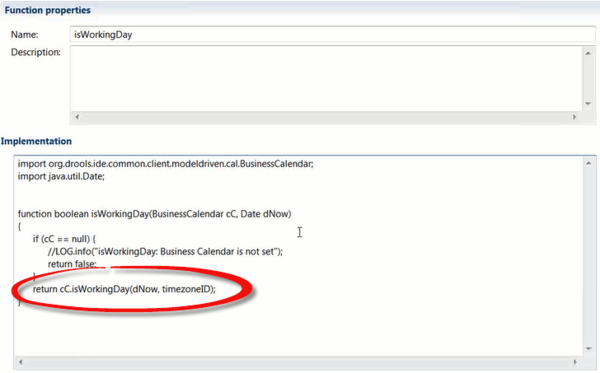
The isWorkingDay condition is then evaluated based on the dynamic timezone passed in by the calling application.
New Method Signatures to the BusinessCalendar Object
The following new method signatures have been added to the BusinessCalendar object, and can be invoked from within a rule function:
- public boolean isWorkingDay(Date theDate, String timeZoneID);
- public boolean isHoliday(Date theDate, String timeZoneID);
- public boolean isException(Date theDate, String timeZoneID);
- public boolean isWorkingTime(Date theTime, String timeZoneID);
- public int diffWorkingDays(Date date1, Date date2, String timeZoneID);
- public int diffWorkingHours(Date date1, Date date2,String timeZoneID);
- public int diffWorkingMinutes(Date date1, Date date2, String timeZoneID);
- public long diffWorkingSeconds(Date time1, Date time2, String timeZoneID);
- public Date beginningOfWorkingDay (Date time, String timeZoneID);
- public Date endOfWorkingDay (Date time, String timeZoneID);
Differentiation between Holidays and Non-Working Days
Business calendars have been enhanced to distinguish between holidays and non-working days. Four new methods have been added to the business calendar object:
- isHoliday()—Returns whether this calendar day is a holiday. Holidays are always non-working days.
- isHoliday(date)—As for isHoliday() but allows you to specify the date to check.
- isException()—Returns whether the day is an exception to the standard work schedule. An exception includes either a time change or a holiday.
- isException(date)—As for isException() but for a specified day.













